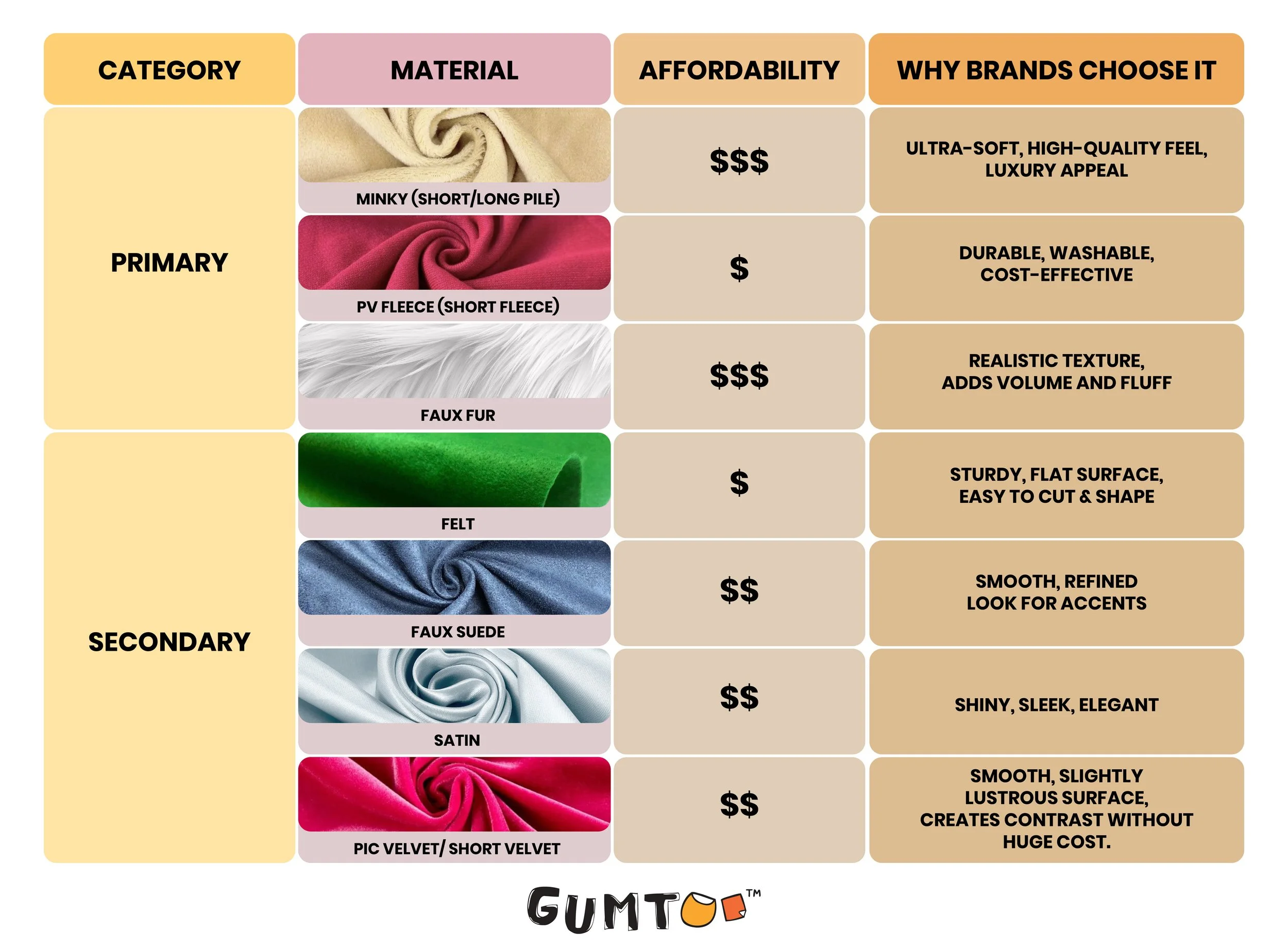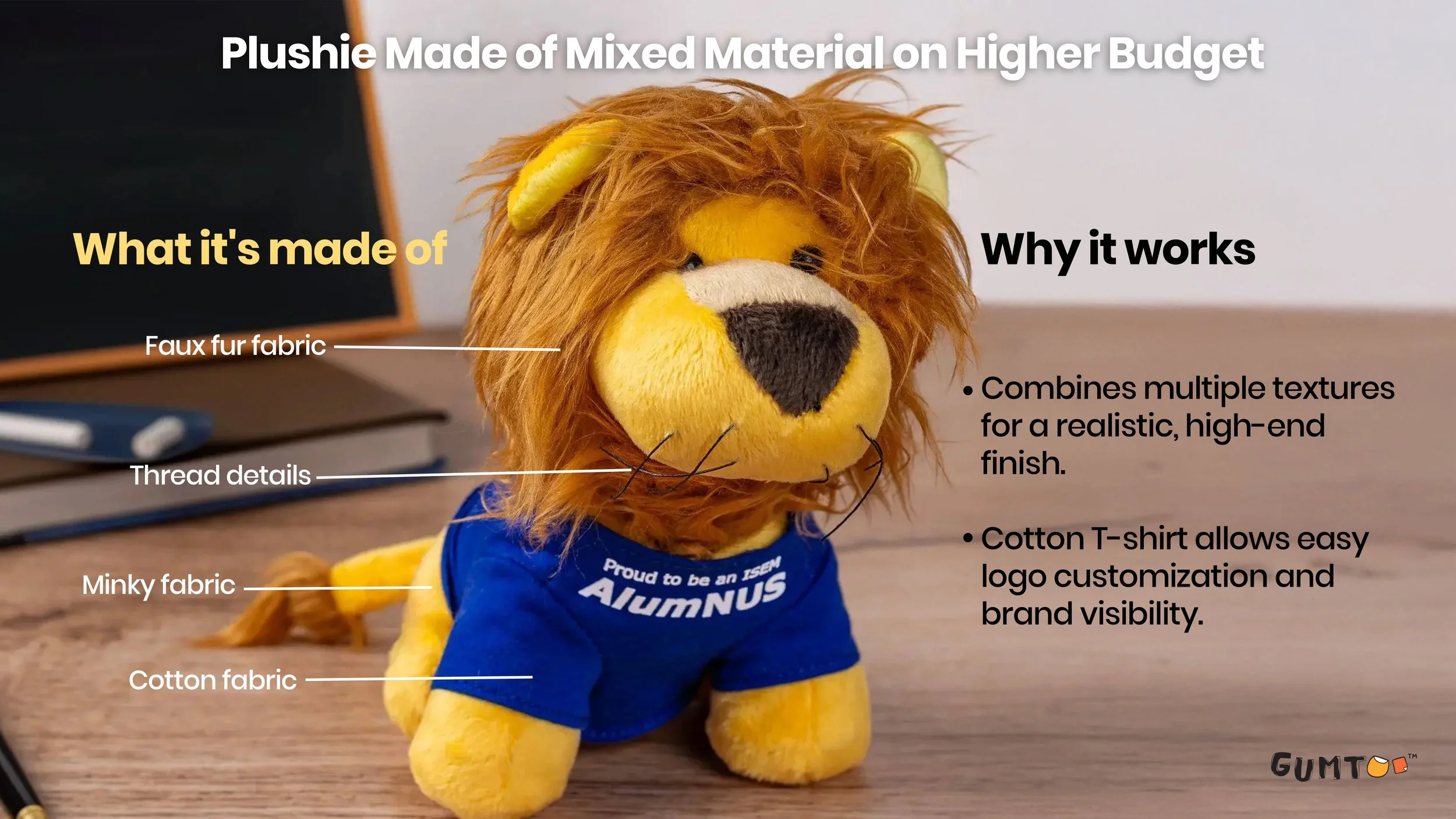Plush Toy Materials 101: How to Choose the Right Fabric for your Plush Toy
The material you choose for your plush isn’t just about softness—it defines how your brand feels in the hands of your audience. Whether you’re creating premium collectibles, kid-safe mascots, or budget-friendly giveaways, choosing the right material is both a business and a technical decision.
Step 1: Understanding Business Criteria
Before diving into fabric textures and pile lengths, start by asking:
“What’s my plush toy meant for — and what’s my budget?”
Most brand managers make the first decision based on business needs — how much to spend, who it’s for, and what purpose it serves. Once those are clear, the right technical choices naturally follow.
Affordability:
Material choice directly impacts cost. Some fabrics are budget-friendly and easy to source, while others are softer or richer in texture and therefore cost more. For example, if your goal is a large giveaway or an event freebie, lightweight, durable materials are ideal for keeping unit costs low. If the toy is meant to be a collectible or limited edition mascot, higher-end materials will justify the premium price.
Usage:
Think about who will receive or use the toy. Plush toys for toddlers and young children need certified, non-toxic, and washable materials. For adult giveaways or decorative souvenirs, brands can prioritize appearance and branding options over certification. In short: choose comfort and safety for kids, or design and branding flexibility for older audiences.
Design of the toy:
This is where the creative and practical sides meet. The toy’s shape and character decide what kind of material works best. Longer fibres make animals or mascots look more realistic, while smoother fabrics help achieve clean, rounded cartoon-style designs. Stretchable or soft materials make curved shapes easier to sew, while sturdier fabrics help toys keep their form during frequent handling.
Step 2: Choosing Materials
Once you’ve mapped your budget and design intent, use this table to find a material that fits both your brand goals and production needs.
Primary Materials: The fabric used for the main body of the plush. This defines the toy’s overall feel and is responsible for most of the tactile impression.
Secondary Materials: Fabrics or elements used for accents, clothing, patches, props, or small areas (eyes, ears, manes, shirts). These create contrast and branding space and can lift perceived value without changing the whole toy’s cost drastically.
Case Study 1: The Hongkong Egglet Plush — Smart Design on a Budget
This adorable Egglet plush was designed as a cost-effective commemorative toy for Hongkong Egglet’s 10th Anniversary. The goal? To create a visually striking yet affordable plush that captured the brand’s personality without using multiple high-cost materials.
The body is made from super-soft fleece, delivering a smooth, huggable feel that looks premium to the touch. The pan and hat are crafted from pic velvet, adding texture and a subtle contrast that keeps production simple and cost-efficient.
Case Study 2: The Lion Plush — Premium Feel, Multi-Material Detailing
When a brand wants their mascot to feel alive, material mixing makes all the difference. NUS also asked for a lion plushie that had more than one element in them to giveaway for their alumni event.
This Lion plush showcases how thoughtful material selection can elevate a mascot into a premium collectible. The soft minky body creates a cuddly base, while the faux fur mane and tail add depth and realism. A cotton T-shirt offers branding space without extra printing costs, and stitched whisker threads add fine detail.
Tip: While these are some of the most popular materials used in plush making, there are many other specialty fabrics available — like satin, terry cotton, lace, bamboo blends, and more. Always consult a plush manufacturer to choose the right fabric mix based on your design, budget, and intended audience.
FAQs
Q1. Can I mix different materials in one plush toy?
A: Yes — in fact, most custom plush toys use a mix of materials. For example, the main body can use a soft, smooth fabric for comfort, while smaller parts like ears, patches, or clothing use a sturdier or shinier fabric. Mixing materials helps brands balance cost, look, and texture — making the toy feel premium without overspending.
Q2. Which materials work best for giveaways versus premium collectibles?
A: For giveaways or bulk events, brands usually choose budget-friendly, easy-to-clean fabrics that still look soft and appealing. Think of light, durable fabrics used for school mascots or event plushies.
For premium collectibles or retail plush, brands go for richer, softer, or textured materials that feel luxurious and photograph well — perfect for display or adult collectors. The choice mainly depends on how the plush will be used and how long you want it to last.
Q3. What’s the most eco-friendly option for plush materials?
A: If your brand focuses on sustainability, go for organic cotton, bamboo fabric blends, or plush made from recycled polyester fibers. These reduce waste and use fewer resources than conventional synthetics. Eco-friendly fabrics are slightly costlier but communicate a strong brand sustainability message, especially for educational, children’s, or eco-conscious campaigns.
Q4. Can my brand’s mascot colors or details be matched exactly in fabric?
A: Usually, yes. Most manufacturers can match your brand’s exact colors using a custom dyeing process based on Pantone color codes. However, note that custom-dyed fabrics may need higher minimum order quantities and slightly longer production timelines. For small runs, choosing the closest available shade from existing fabric stock can save both time and money.
Q5. Does the fabric choice affect production time?
A: Yes, a little. Common materials that are already stocked (like standard soft plush fabric) can be sourced quickly, so production moves faster. On the other hand, special fabrics — such as ones with long hair textures, custom colors, or complex finishes — may take longer to prepare or stitch.
If your project has a strict deadline (for events or product launches), let your manufacturer know early so they can recommend available alternatives that look and feel similar.
Q6. How do I know which material suits my brand best?
A: Start with your budget and purpose. If you need a fun, durable toy for large-scale giveaways, choose lighter and more affordable materials. If you’re building a collectible or mascot for long-term use, invest in a softer, richer fabric that adds to brand perception. You can always mix both — use premium accents where people notice touch or texture, and keep the rest simple to stay on budget.




